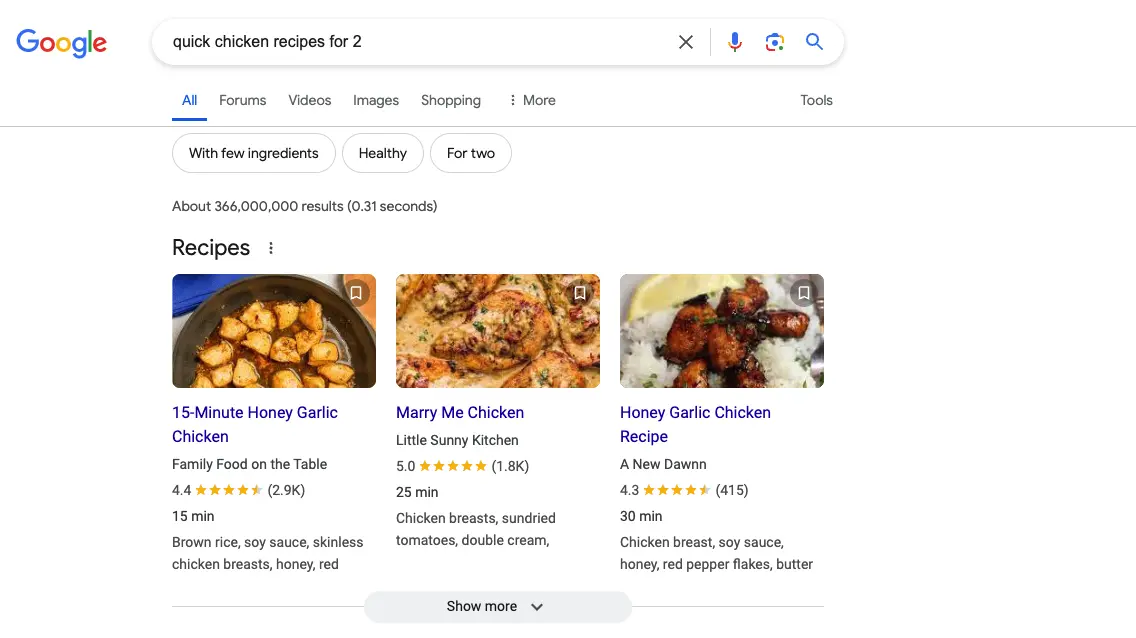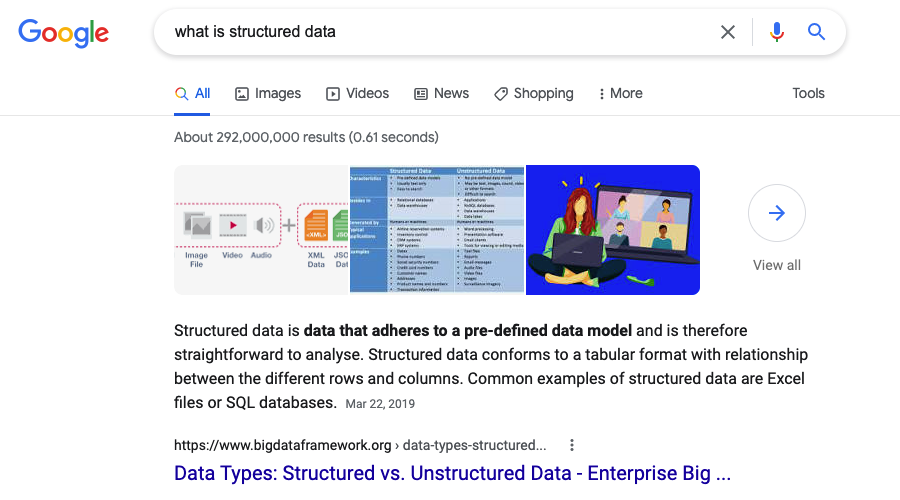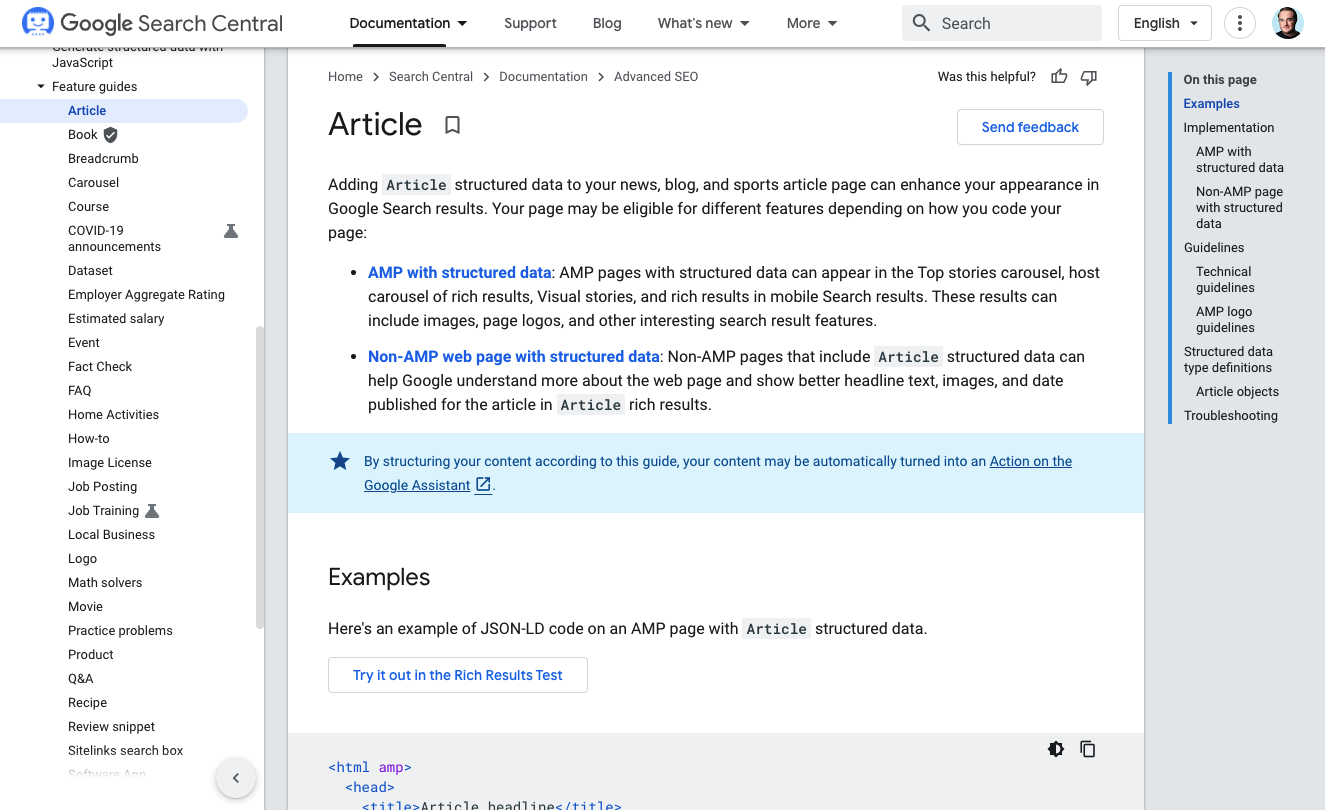Introduction to Structured Data for SEO

In this article I’m going to be covering the basics of structured data, the various types, and how they’re used to generate Rich Snippets on search. Let’s get started.
What is structured data in the first place?
Put simply, structured data allows machines to understand human-readable content. By using it we can help search engines better understand our pages’ content and its meaning. To give you an example, structured data helps search engines like Google to display relevant results for a query such as “quick chicken recipes for two”.
Without structured data, Google would have a much tougher time with a query like this. For all pages with chicken recipes, because of structured data, Google can look at the cooking time, and the serving size and provide you with more relevant results.

So we know that we know what structured data is, what about unstructured data?
Put simply, it is everything else: web page content, images, video, and more.
Search engines have to work much harder to understand unstructured data. For text, Google uses natural language processing to understand content sentiment and the meaning of words in sentences. This includes parsing the grammatical structure of sentences, recognizing entities, such as names of people, places and organizations, and understanding the relationships between those entities.
Google also has systems in place to identify what images are of, as well as the entities depicted in images, and can even extract the text from them. As evidence look at something like Google Lens.
Structured Data allows machines to understand meaning through an organized format that adheres to a specific schema or model.
In particular, the format that major search engines have agreed upon is schema.org, which you’ve most likely heard before. For now, the main point that I want to get across is that structured data conveys meaning.
I recommend that SEOs familiarize themselves with microdata and JSON-LD. I’ve got nothing against RDFa. But there aren’t as many circumstances where it’s going to be important. Microdata was Google’s preference before JSON LD so if you’re faced with a situation where you have to use something else, microdata is typically a safe choice.
With JSON-LD, we need to be able to get the script tag in the head and the body of your HTML document. If you’re using WordPress, you’re probably using a plugin for this such as script to head or header footer code snippets, which I think now is just WP code. You will face situations where there are limitations.
Once I had to do product descriptions for a national pet supply retailer and all I had was a text box, and I couldn’t put script tags to add JSON-LD. Other HTML was fine though. So I used microdata. The point to be taken here is that adding a script to the head wasn’t possible. Knowing microdata allowed me to improvise.
However, JSON-LD is what you’re going to be using most of the time, so I encourage you to get familiar with it. One of the main reasons that SEOs like JSON-LD is the same reason that developers like JSON. It’s very expressive and easy to write, and it can exist outside of the HTML markup of a page. JSON-LD is a modern approach that works especially great for dynamic content.
Structured data blurs the lines between On-Page SEO and Technical SEO. While it probably depends on who you ask, I would consider it to be an on-page type of optimization, just like optimizing title tags and meta descriptions.
So, we know that we can put JSON-LD in both the head and the body of a page. Making the right choice depends on the type of content that you’re wanting to mark up.
The types of structured data that you’re going to want to put in the head is your main page defining schemas such as Article and webPage.
Anything else might go in the body, however, that’s sort of ambiguous. A good example here would be to think about how you would mark up a blog page or product page on a website.
The main schema would go in the head, but then we might mark up some collection items in the body and use structured data to connect two the two things together.
Structured Data for SERP Features
In SEO we are primarily interested in structured data for rich snippets and SERP features because they can influence our organic CTR, and in turn, help us get more traffic and in turn more revenue for our clients. We can also use structured data to convey semantics, but first, we’re going to talk about rich snippets.
Rich Snippets are enhanced search results that provide additional data beyond the standard title, URL, and meta description. Google displays them to help users better understand content and show users what’s on a webpage before they click on it.
You commonly see these things like answer boxes (also known as the “featured snippet”, video thumbnails, and event dates, and there are others.

Some might consider the answer box section to be more of a SERP feature than a rich snippet. I would probably call it a SERP feature as well because it’s not really something that is actionable.
I would consider rich snippets to be things that are actionable; something that you can have more control over versus something like an answer box, which is totally subjective to Google. Which brings me to my next point.
How does Google decide when to show rich snippets?
Well, it largely depends on the user’s query, and how helpful Google thinks a rich result is going to be at the time. It’s usually based on search intent and contextual relevance to the query. So yeah, an answer box will be far less actionable than many other types of rich snippets, such as a product or course carousel.
A very helpful tip from Steve Toth that I definitely would recommend for the answer box / featured snippet is to write a direct answer to a query in 230 characters and put it on your page. It has worked for me in the past; if I had to give a percentage of the time, maybe seven out of ten times the 230-character rule works.
So it’s definitely reliable, and I recommend doing it because it doesn’t even require any structured data. Now, if you also provide structured data, that’s definitely a benefit, but that strategy works perfectly fine without it. The only thing I might add is to put it toward the top of your page, if not the first content before the main content of the page.
Google’s going to try to extract most of the information you put in structured data for rich snippets from the content through its natural crawling processes
This actually brings up a good point, which is that Google’s going to try to extract most of the information you put in structured data for rich snippets from the content through its natural crawling processes. Structured data is really just sort of “bridging the gap”, or “teeing it up” for them. It’s like you’re providing it on a silver platter – “here is my data oh, search engine”. So it’s really just making it easier.
Adding structured data to a web page is not an automatic means to generate Rich Snippets. It is ultimately up to Google to decide when and where to display them for a result.
The Benefits of Rich Snippets
Now let’s talk about the benefits of rich snippets. Why should you go after them? Increased click-through rates are by far the highest benefit. But ultimately, like everything else in SEO, it depends.
As far as products go, various types of rich snippets can provide users with additional information about your products that can help them make better buying decisions.
For other things like movies, podcasts, episodes, and even services. Review snippets can increase confidence among users.
Competitive Advantage
Rich Snippets can definitely give you a competitive advantage on SERPs well. If your result is ranking fourth, and has a review snippet indicating a five star rating, and your competitor that’s occupying the third spot doesn’t have any rich snippets, your chances of getting the click are much more likely because your review snippet is going to make your page stand out.
Things like review snippets can increase face value confidence and trust. However, they have to be backed by real review data. You can’t just fake a number.
In a study conducted by Milestone Research, users were 49.5% more likely to click on enriched results compared to standard search results.
A 58% CTR compared to a 41% CTR is significant. However, we shouldn’t take this as fact. It’s just one study. Although, regardless of its statistical significance, for our purposes, it’s still practically significant. It makes sense that users would be much more likely to click on a rich result.
SERP Feature Gallery
Google’s SERP Feature Gallery provides detailed documentation on the types of features it displays that use structured data. Some of them are automatically generated, such as the Knowledge Graph and answer boxes, but most of them can be coded for on your website.
Below is a screenshot showing the feature guides section of Googles search appearance documentation.

The first feature guide listed is for articles. You can see on the left all of the additional guides available.
Future Proofing Your Content for New Rich Snippets
For a while now, I’ve been testing wrapping lists of products and even blog posts on a /blog page in itemList structured data. Coincidentally, Google has begun calling for carousels call for items to be nested an itemList property.
This is why I recommend writing structured data in a more expansive sense than what is required for Rich Snippets, and try to study schema.org and write the structured data that you think makes sense for a page. Because I did that with itemList for clients products and blog pages, both my content and my clients content are already prepared for this SERP feature.
So I can’t emphasize enough that in SEO if you try to stay ahead of the curve, I promise you’ll be rewarded. In this case, I got lucky.
What Structured Data is Not
A lot of misinformation goes around Twitter X and even LinkedIn. Before signing off, I just wanted to make sure to make this explicitly clear. Structured data is not a rankings factor.
In theory, if structured data helps search engines better understand your content, then in turn, couldn’t providing and have your content ranked better?
In theory, yes, but even then, many SEOs including myself would probably call that more of a signal. There is no evidence that structured data has anything to do with ranking.
If you liked this article on the basics of structured data for SEO, you might be interested in this one too:
Why Structured Data is important for Semantic SEO
Not many people talk about how structured data can be used for semantic optimization, however, I’d argue that comprehensively marking up entities in your content is important for every Semantic SEO strategy. This is because while Google for example mostly uses structured data as a means to communicate data for rich results, their systems most definitely understand a vast amount of Schema.org.

